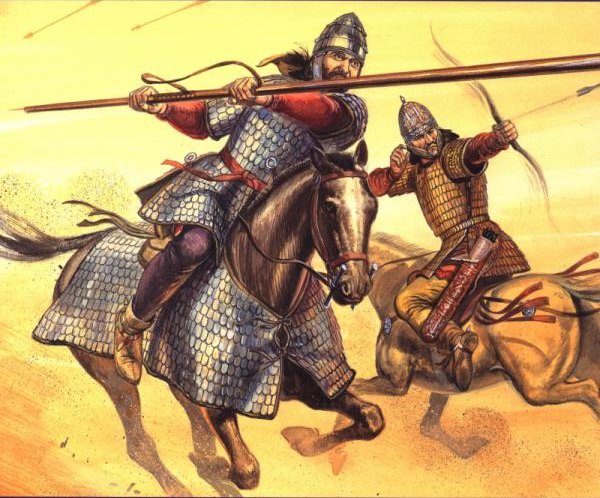History of the Ossetians, Part II: The Horsemen

OK. So there are lots of Iranian speaking tribes out on the steppes north of the BMAC People around 900 BC. Tribes of them move west and east with their new skills as horsemen. They no longer use chariots and they no longer farm, even part time. They are true horse nomads. Those who head west settle into the Ukraine and around the Black Sea over to the Danube and are called Scythians by the Greeks. Their eastern cousins are called the Saka by the Persians. Way off even further to the east weird things happen and the Iranians who disappear in that direction undergo some changes.
Soon the Easterners return as a new people, the Sarmatians. They defeat and absorb their western cousins the Saka and the Scythians (this will happen over and over - I think the Cossacks are just the last transformation of these peoples who learned Russian and became Orthodox Christians).
The picture shows some Sarmatian warriors who move all the way to the Danube and eventually ended up fighting the Romans (didn't everybody?). BTW, some of the warrior aristocracy of the Sarmatians were women, and judging from the wounds on their bones and the wear on their weapons, they really did fight: hence the Amazon stories. The poet Ovid got to meet some of these people up close and personal when he got exiled out to the worst rat hole in the Roman empire by Augustus. He didn't like them.
When the Sarmatians were fighting the Romans under Marcus Aurelius (a war that shows up in the first 15 minutes of "Gladiator" and the first five minutes of "King Arthur") they were defeated and had to send five thousand of their best warriors to Britain to serve as Roman cavalry. They and their horses were completely armored - almost like later medieval knights. And, in fact, the King Arthur stories share some elements with later Ossetian legends, especially the sword in the lake motif.
Meanwhile, the far eastern tribes, once again, met something out there in the East that changed their culture enough to be called a new people: the Alans. These guys were hell on horseback.
I'll talk about them tomorrow. Don't worry, the Ossetians show up soon.


3 Comments:
Keep posting! Your summary of ancient history is accurately captures the basic facts and is highly entertaining. My request: the Goths.
Zaparozhian Cossacks were not from the lineage of Sarmatians. Sure their tactics were passed down because steppe warfare never really evolves that much. Cossacks were runaway slaves/serfs. I don't know about the Don Cossacks though, so maybe you are right.
Yep, that is the usual explanation. But both I and my collaborator, the Mad Cossack, who is really a Cossack who was born and raised in North Ossetia, are convinced that there were already blond blue eyed horsemen out there who were already Orthodox Christians.
But that's just our opinion. Wait for our book.
Post a Comment
<< Home